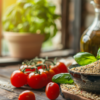Sustainable Living: Cooking with Seasonal Superfoods
Introduction
Eating fresh, seasonal produce not only enhances the flavor of your meals but also contributes to a more sustainable planet. By cooking with seasonal superfoods, you not only get the maximum nutritional benefits but also support local farming and reduce your carbon footprint. This blog will guide you through utilizing seasonal superfoods in your daily meals, offering tips, recipes, and insights on how these powerful foods can benefit your health and help preserve our environment. Join us on this tasty journey to a healthier lifestyle and a healthier planet!
Benefits of Sustainable Living

Embracing sustainable living through the use of seasonal superfoods offers benefits that permeate almost every aspect of life. From improving personal health to promoting environmental sustainability, the perks of integrating eco-conscious food choices are profound and impactful.
Health benefits of seasonal superfoods
Seasonal superfoods are packed with essential nutrients that peak in their natural harvest season. Consuming these foods at their nutritional zenith means your body receives optimal levels of vitamins, minerals, and antioxidants. This confluence of freshness and nutrient density helps in boosting your immune system, enhancing skin health, and increasing energy levels. Moreover, eating seasonal superfoods can contribute to a more balanced diet, as these foods often introduce a variety of natural flavors and textures that can make meals more enjoyable and satiating.
Environmental benefits of cooking with seasonal produce
Choosing seasonal produce directly contributes to reduced carbon footprints as it often requires less transportation and packaging compared to out-of-season, imported goods. This reduction in transport and plastic use significantly lowers greenhouse gas emissions and waste. Additionally, seasonal cooking supports local farmers and markets, which can lead to more sustainable agricultural practices. This local economy boost aids in preserving the community’s farmlands and natural resources, creating a healthier ecosystem for future generations.
What are Seasonal Superfoods?
Understanding what makes certain foods “superfoods” can help you make better dietary choices that are both beneficial to you and the environment.
Definition of seasonal superfoods
Seasonal superfoods refer to foods that are naturally at their nutritional peak during a specific time of year. These foods not only provide exceptional health benefits due to their high concentration of nutrients, but they also offer better flavors and textures. Integrating these foods into your diet allows you to eat in harmony with the natural production cycles, which can be more environmentally and economically sustainable.
Examples of popular seasonal superIt’s important to recognize which foods are considered superfoods in different seasons:
– Spring: Asparagus, strawberries, peas, and leafy greens like spinach and arugula.
– Summer: Berries, tomatoes, cucumbers, and beans.
– Fall: Apples, pears, squash, and root vegetables like beets and carrots.
– Winter: Citrus fruits, kale, and nuts like almonds and walnuts.
These are just a few examples; the variety expands vastly across different regions and with local farming practices.
Nutritional benefits of seasonal superfoods
The nutritional content of seasonal superfoods is higher compared to foods grown out of season. For instance, vitamin C, crucial for immune system function, is more abundant in citrus fruits harvested during the peak winter months. Similarly, beta-carotene, which the body converts to vitamin A, is richly found in carrots and squash harvested in fall, making them excellent for eye health and immune support. Additionally, leafy greens harvested in the spring offer high levels of folate, essential for cell growth and metabolism. Eating these and other seasonal superfoods helps in maintaining a healthy body weight, reducing the risk of chronic diseases, and promoting overall vitality.
Importance of Cooking with Seasonal Superfoods
Cooking with seasonal superfoods not only boosts your health but also supports sustainable living in several powerful ways. Incorporating these nutrient-packed foods into your diet when they are naturally ready for harvest aligns your eating habits with the rhythms of nature, ensuring that you derive the most benefit from their fresh, vibrant flavors and potent nutritional profiles.
Supports local farmers
Choosing seasonal superfoods helps support local farmers and growers. When you buy locally grown produce, you contribute directly to the local economy. This support is crucial for the livelihood of farmers who rely on the community to thrive. By purchasing locally, you also help preserve farmland and rural livelihoods, maintaining the agricultural landscape and preventing urban sprawill.
Reduces carbon footprint
Eating seasonally reduces your carbon footprint significantly. Foods grown out of season often require more energy for growth and transportation compared to those grown within their natural seasons. Seasonal foods, by contrast, typically travel shorter distances to market, which reduces greenhouse gas emissions related to transportation, cold storage, and artificial growing conditions like heated greenhouses.
Better taste and freshness
Seasonal superfoods are at their peak in both flavor and nutrients. Fruits and vegetables harvested during their appropriate seasons are naturally ripened and harvested at the right time, which enhances their taste and nutritional values. For instance, a tomato picked during summer can taste significantly sweeter and juicier compared to one that’s artificially ripened and sold during winter.
Seasonal Superfood Recipes
Embracing seasonal cooking can expand your palate and allow you to experience the real pleasure of eating food that tastes as it’s meant to taste. Below are some delicious, easy-to-prepare recipes categorized by season that feature some of the best superfoods available.
Spring recipes
– Strawberry Spinach Salad: Combine fresh spinach with sliced strawberries, nuts, and a vinaigrette dressing. Both spinach and strawberries are spring favorites and pack a hefty nutritional punch.
– Asparagus and Pea Risotto: Utilize the freshness of asparagus and peas to whip up a creamy risotto, perfect for a comforting spring dinner.
Summer recipes
– Grilled Zucchini and Corn Salad with a lime dressing: Take advantage of the abundance of zucchini and corn available in the summer. Grill them for an added smoky flavor, then toss with lime, olive oil, salt, and herbs.
– Berry Quinoa Salad: Mix cooked quinoa with a variety of fresh berries, mint, and a honey-lemon dressing for a refreshing and nutrient-rich meal.
Fall recipes
– Pumpkin Soup: Nothing says fall like a warm, creamy pumpkin soup spiced with ginger and cinnamon. Pumpkin is not only seasonal but also rich in vitamins and fiber.
– Roasted Brussels Sprouts with Pomegranate: Roast Brussels sprouts until caramelized and toss with seeds from a fresh pomegranate, a superfood known for its antioxidant properties.
Winter recipes
– Sweet Potato and Black Bean Chili: Combine sweet potatoes, black beans, and tomatoes for a hearty, warming chili perfect for cold winter nights.
– Kale and Roasted Almond Salad: Kale, which thrives in cooler weather, can be tossed with roasted almonds and a tangy vinaigrette for a crunchy, vibrant winter salad.
Each recipe brings out the best in its seasonal superfoods, making your meal not just delicious but also ecologically and ethically sound. By adapting what you eat to the season, you ensure every meal is fresh, tasty, and environmentally friendly.
Tips for Incorporating More Seasonal Superfoods

Eating seasonal superfoods isn’t just a trend; it’s a healthy and sustainable way to approach your daily diet. These powerhouse ingredients are at their nutritional peak during specific times of the year, meaning they not only taste better but also offer more health benefits than foods grown out of season. Here are a few tips on how you can incorporate these nutritional champions into your meals.
Shopping at farmers markets
One of the best ways to ensure you’re getting the freshest seasonal superfoods is by shopping at your local farmers market. Here, you can find a plethora of fruits, vegetables, and other products that are not only locally sourced but also harvested at their peak nutritional value. When you shop at farmers markets, you:
– Support Local Farmers: Buying directly from growers helps sustain their operations and the local economy.
– Reduce Your Carbon Footprint: Locally sourced produce doesn’t travel long distances, significantly reducing transportation emissions.
– Discover New Varieties: Often, local farmers grow unique or heirloom varieties that you won’t find in regular supermarkets.
Growing your own produce
If you have space, growing your own produce is a wonderful way to connect with your food and ensure it’s as fresh as possible. Start with easy-to-grow seasonal superfoods like tomatoes, bell peppers, and leafy greens. Growing your own food means:
– Complete Control: You control the growing conditions and avoid the use of harmful pesticides and fertilizers,
– Immediate Access: Fresh produce is just a few steps away—perfect for last-minute meal additions,
– Educational Experience: It’s a great way to learn more about how food is grown and to teach children about sustainable living.
Meal planning around seasonal produce
Meal planning is key to successfully incorporating seasonal superfoods into your diet. Start by researching which foods are in season and plan your meals around these ingredients. This not only ensures peak flavor and nutrition but also often leads to cost savings as seasonal produce is generally less expensive. Here are some strategies:
– Batch Cooking with Seasonal Ingredients: Prepare soubs, stews, or casseroles in large quantities to enjoy throughout the week.
– Incorporating Variety: Aim to try at least one new seasonal vegetable or fruit each week to diversify your diet.
– Flexibility is Key: Be open to substituting ingredients in your favorite recipes based on what’s currently available and in season.
By keeping these ideas in mind, you can enjoy a diet rich in flavor, nutrition, and sustainability, subtly aligning daily habits with ecological responsibility.
Conclusion
Eating seasonally not only promotes a healthier diet but also supports sustainable living practices. By choosing seasonal superfoods, you’re not just nourishing your body with the best nature has to offer at any given time, but you’re also reducing your carbon footprint and bolstering local farming communities. Embrace the variety and richness each season brings to your table. Happy cooking, and here’s to making every meal an opportunity to support a healthier, greener world!










